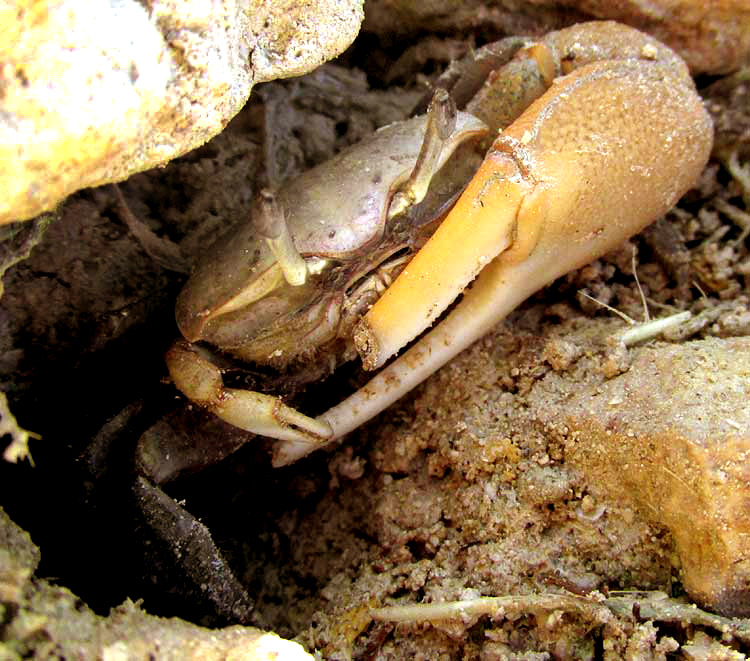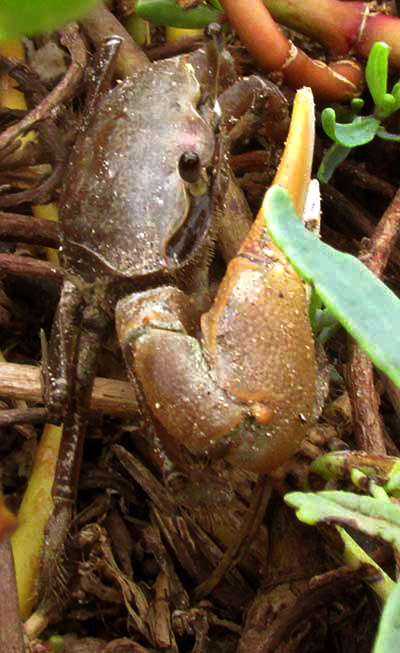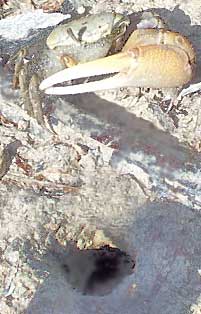Excerpts from Jim Conrad's
Naturalist Newsletter

from the November 9, 2014 Newsletter issued from Río Lagartos, on the Yucatan Peninsula's northern coast (~N21.60°, ~W88.16°), Yucatán state, MÉXICO
MUDFLAT FIDDLER CRABS
Above you see a fiddler crab next to his hole, with the top "movable finger" of his big, "fiddle-like" claw broken off. A side view showing how small the body is compared to the big claw is shown below:

To give an idea of this fiddler's size, the big claw of this species reaches about 2-½ inches (6.3 cm) in length.
During my first visit to the Yucatan's northern coast in 2006 I saw that male fiddler waved their big claws to attract females, who have only small claws, and fought off potential male competitors with them. However, I never solved the mystery of why some males had their big claws on the right side, while others had them on the left. I'd assumed that two species were involved, though they all seemed the same to me. Now I read in a research paper by Backwell and others (Proc Biol Sci. Nov 7, 2007) that among fiddler crabs, "In most species, 50% of males have a major claw on the left and 50% on the right."
Back then, seeing that about a hundred fiddler crab species were recognized, and that their taxonomy was in a mess, I didn't assign a name to our northern Yucatan fiddlers. Since then more literature and pictures have become available on the Internet, so now I'm comfortable to identify our common crab along the margins of mangrove swamps as Mudflat Fiddler Crabs, UCA RAPAX. Mudflat Fiddler Crabs are distributed along the Atlantic and Gulf of Mexico coasts from the Daytona Beach area of Florida in the US to São Paulo, Brazil, and all through the Caribbean Islands.
The Smithsonian Marine Station at Fort Pierce, Florida provides a fine web page all about the Mudflat Fiddler Crab's natural history, including its "fiddle waving," at http://www.sms.si.edu/irlspec/Uca_rapax.htm.
from the February 11, 2006 Newsletter issued from near Telchac Puerto on the northcentral coast of Yucatán, MÉXICO
FIDDLER CRABS
 You see them at low tide where the water has withdrawn from the dark mangrove wall surrounding the lagoons, leaving extensive mud flats. Especially you see them where Black Mangrove roots sprout thousands of slender, gray-brown, pencil-like, oxygen-absorbing pneumatophores up through the mud surrounding the trees. There scooting sideways across the mud down in the knee-high pneumatophore jungle you'll see fiddler crabs, sometimes just one or two, but sometimes thousands, incredible cities of them sitting quietly until you make the wrong move, and then they all stampede in Alfred-Hitchcockian single-mindedness. That's a fiddler at the right, and his hole. Note the fiddler's stalked eyes and the spume he's making, visible right above the claw's whitest part.
You see them at low tide where the water has withdrawn from the dark mangrove wall surrounding the lagoons, leaving extensive mud flats. Especially you see them where Black Mangrove roots sprout thousands of slender, gray-brown, pencil-like, oxygen-absorbing pneumatophores up through the mud surrounding the trees. There scooting sideways across the mud down in the knee-high pneumatophore jungle you'll see fiddler crabs, sometimes just one or two, but sometimes thousands, incredible cities of them sitting quietly until you make the wrong move, and then they all stampede in Alfred-Hitchcockian single-mindedness. That's a fiddler at the right, and his hole. Note the fiddler's stalked eyes and the spume he's making, visible right above the claw's whitest part.
The feature making them fiddler crabs and not just crabs is that one of the male's two claws is much, much larger than the other claw. (The technical name for a crab's claw is "cheliped.") Hermit crabs also bear one oversized claw, but hermits live in abandoned seashells, for their bodies are not well protected with armor. Hermits use their big claws to close up their shells' openings when they retreat into the shells. I've not seen hermit crabs here but I'll bet a snorkeler surveying the sandy floor just offshore would see one.
Male fiddlers eat with their small claw while holding the large claw before them -- like a fiddle. As the small claw moves back and forth between the ground and the mouth, it looks almost as if the crab were sawing at his fiddle with a bow. You can see an animated GIF demonstrating this action, and find links to other fiddler pages, at http://www.fiddlercrab.info/
Fiddlers eat algae and other organic material their small claws can handle. The male's big claw is used for impressing females and for flaunting when competing with other males for territory. If a big claw is lost, a small one replaces it. Fiddlers dig tunnels in the mud or sand and stay there during high tide. This means that they feel at home both above water and out of it.
About 65 species of fiddler crab are known. I've seen two or three species here but I don't know which they are, though all fiddler crab species appear to belong to the genus UCA.
from the February 18, 2006 Newsletter issued from near Telchac on the northcentral coasst of Yucatán, MÉXICO
AWAKENING TO FIDDLER CRABS
Many times in my life I've made memorable nature observations thanks to my hypoglycemia. It works like this:
I'm out wandering, my blood sugar drops very low and I get profoundly sleepy. I lie down and when I awaken my prolonged quietness has caused animals in the area to forget my presence. As I lie there unmoving I can watch animals behaving as if I weren't there.
This happened to me the other day. At Hotel Reef I'd just enjoyed my weekly breakfast of beans and tortillas. Maybe I'd eaten too much because when soon thereafter I was wandering among the mangroves and my breakfast carbohydrates began breaking down into glucose, my pancreas started overproducing insulin, my blood sugar dropped drastically, and I just had to take a nap. Next to the new, post-hurricane causeway across a lagoon a big limestone rock had tumbled amidst some mangroves so I just lay down on the rock and went to sleep.
When I awakened I found myself gazing into a tangled jungle of living and shattered mangrove stems, sprawling aerial roots and vertically rising pencil- like pneumatophores. The tide was low so the floor of the tangle was coated with a greenish-gray slime of mud and algae left by the receding water.
Stationed three to five inches apart across the slimy jungle floor were little fiddler crabs about the size of the last joint of my small finger, and they were all signaling in fiddler-crab semaphore.
They were squat, dark creatures, each bearing a single oversized, pale to almost white claw. The signaling consisted of a quick movement of the pale claw rather like the chopping action of a karate expert breaking a brick on a table before him. Each crab's choppings were separated by about five seconds. These were males defending their slimy territories by flaunting their big claws.
My first reaction was how ridiculous it all as, those dozens of creatures expending such energy waving their big claws about. However, as I studied the situation I began seeing that there was some sense to it.
For, if you watched long enough, you could see that each crab had his own chopping technique. Some chops were fast, crisp and evenly spaced while others were half-hearted and/or erratically spaced. Some choppers seemed to lose their train of thought and their chipping trailed off, while others chopped obsessively. Some crabs chopped from the center of large patches of algae-rich slime, which they fed on while they chopped, but others chopped from corner plots hemmed in by roots and stems where the mud showed little green cast, and therefore contained little algae for eating.
In fact, it looked like the best choppers usually occupied the largest and/or greenest plots. The feeblest choppers usually occupied the least-green spots or spots more exposed above to attack by birds and other predators. I would not give crabs credit for being able to rationally deduce the meanings of symbolic gestures, but I do believe that over time evolution can encode in crab genes the message understood by all crabs that "If this individual can deliver such a fine karate chop with his big claw, just consider what might happen if real combat over this slimy plot should take place... "
Gradually my blood sugar level rose, my brain awakened, and things around me began making sense. How beautiful was that slimy world in which dozens of flashing, symbolic karate-chops diverted big claws from being used in ignorant combat.